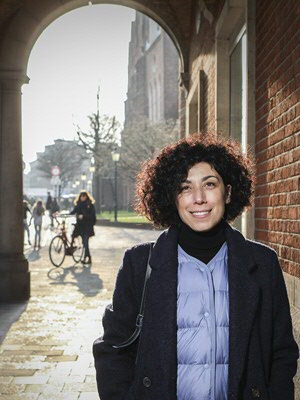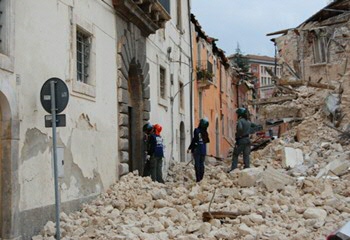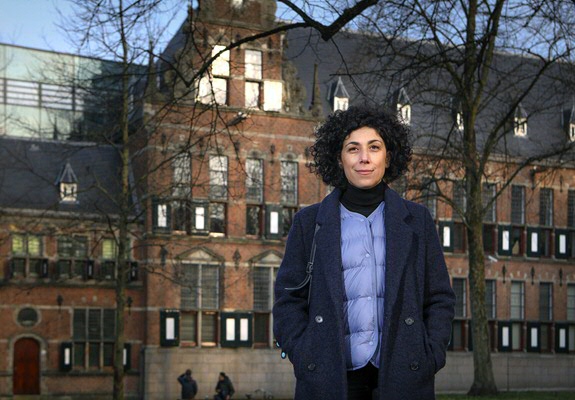Waarom is crisiscommunicatie zo moeilijk?

Hoe kunnen autoriteiten het best communiceren over dreigende crisissituaties? Francesca Giardini houdt zich met deze vraag bezig, nadat zij zelf de gevolgen ondervond van een aardbeving in haar geboortestad. Ze onderzoekt hoe sociale interactie ervoor zorgt dat mensen meer of juist minder dreiging ervaren. Dat helpt om menselijk gedrag beter te begrijpen, bijvoorbeeld tijdens de coronapandemie.
Tekst: Beau Oldenburg / Foto’s: Henk Veenstra
Aardbeving
Op 6 april 2009 werd het Italiaanse L’Aquila - de geboortestad van Francesca Giardini, socioloog aan de RUG - volledig verwoest door een aardbeving. Meer dan 300 mensen kwamen om het leven. In de maanden voorafgaand aan de aardbeving voelde men diverse lichte schokken. Hoewel zulke schokken in het verleden vaker een voorbode voor een grotere beving waren geweest, hielden de autoriteiten vol dat er geen reden tot paniek was.
Vertrouwen
Ruim elf jaar later inspireerde deze ingrijpende gebeurtenis - samen met de Groningse aardbevingsproblematiek en de coronapandemie - Giardini om onderzoek te doen naar crisiscommunicatie. “In L’Aquila is het toendertijd overduidelijk misgegaan. Doordat de autoriteiten suggereerden dat er niets aan de hand was, waren de meeste mensen thuis op het moment van de aardbeving. Terwijl we vaker met aardbevingen te maken hadden gehad en eigenlijk wel wisten dat we beter naar buiten konden gaan en desnoods een nachtje in de auto moesten slapen. Het is bizar hoeveel vertrouwen we in de autoriteiten hadden.”

Geen echte mensen maar agents
Giardini’s onderzoek centreert zich rond de risicoperceptie van individuen; de mate waarin mensen dreiging ervaren. Als socioloog is ze bijzonder geïnteresseerd in hoe sociale interactie deze perceptie beïnvloedt. Omdat dit lastig te onderzoeken is bij mensen, gebruikt ze zogenaamde agent based models, waarin opvattingen en gedrag van mensen gesimuleerd worden. In Giardini’s modellen krijgen de gesimuleerde personen, ook wel agents genoemd, informatie over de kans dat een bepaalde ramp zich voordoet en ‘praten’ hier vervolgens met elkaar over. Giardini: “Je ziet hoe de risicoperceptie van de gesimuleerde personen langzaam maar zeker verandert door het contact dat ze met elkaar hebben. Deze subtiele veranderingen zijn heel lastig te onderzoeken bij echte mensen.”
Paniekzaaiers
Doordat men elkaar beïnvloedt, ontstaan er clusters met mensen die ongeveer dezelfde opvattingen hebben, zag Giardini. Zo ontstond er een groepje wat ze omschrijft als ‘alarmists’ - vrij vertaald ‘paniekzaaiers’. Zij ervaren een hoge dreiging, een flink stuk hoger hoger dan de werkelijke dreiging, en hebben weinig vertrouwen in de autoriteiten. Ze bleken anderen te kunnen meetrekken in hun paniek. Door het contact met een alarmist worden mensen dus banger. Giardini: “Dat heeft waarschijnlijk te maken met het feit dat alarmists het meest over de dreiging praten. Enerzijds om anderen op de hoogte te stellen, anderzijds om hun eigen gemoederen te sussen.”
Complotdenkers
Een andere interessante groep waren de ‘complotdenkers’. Net als de alarmists hebben zij weinig vertrouwen in de autoriteiten, maar deze groep ervaart vrijwel geen dreiging. Giardini: “Mensen in deze groep hebben bijzonder weinig vertrouwen in de autoriteiten maar hebben wel een grenzeloos vertrouwen in elkaar. Deze mensen zijn lastig te bereiken omdat ‘sceptisch zijn’ uiteindelijk een belangrijk onderdeel van hun identiteit wordt. Het gaat dus over veel meer dan een simpele mening. Dit verklaart waarom je hen amper bereikt met informatie, ze staan hier simpelweg niet voor open.”

Corona
Giardini’s onderzoek biedt handvaten om het gedrag van mensen tijdens de coronapandemie beter te begrijpen. Bijvoorbeeld waarom sommige mensen de pandemie in zijn geheel ontkennen en zich niet aan de regels houden, terwijl anderen al een jaar in zelfisolatie zitten. Giardini: “Mijn onderzoek laat zien dat informatie niet altijd binnenkomt zoals deze bedoeld is. Sommige mensen zijn zo bang, dat de informatie vervormd raakt. Anderen vertrouwen meer op wat ze via via horen dan wat er via de officiële kanalen gezegd wordt.”
Open zijn over risico’s
Volgens Giardini is de uitdaging voor overheden om transparant en open te zijn over risico’s zonder daarbij paniek te veroorzaken. “Ik hoorde dat in Duitsland de risico’s wat aangedikt waren om te zorgen dat men zich beter aan de regels houden. Dat is een linke strategie. Voor hetzelfde geld durven mensen hun huis niet meer uit of gaan ze plunderen of rellen. Ik zou daarom adviseren het zoveel mogelijk bij feiten te houden. En tegelijkertijd in het achterhoofd te houden dat mensen je boodschap waarschijnlijk anders interpreteren dan je gehoopt had.”
Inzicht in kansen
Giardini denkt daarnaast dat het goed is als er meer aandacht komt voor het interpreteren van kansen. “Ik heb het idee dat veel mensen dat lastig vinden. Als risico’s gecommuniceerd worden, is het misschien geen gek idee om meer aandacht te besteden aan hoe je dat nou precies moet opvatten. Als mensen de risico’s goed begrijpen, kunnen ze een betere afweging maken. Tegelijkertijd laat mijn onderzoek zien dat risicoperceptie meer dan alleen een individuele aangelegenheid is.”
Meer informatie
- Francesca Giardini
- Van 5 tot 9 juli organiseert Giardini samen met collega Clara Egger de Summer School Cascading Disasters, Institutions and Organizations. Towards resilient organizations, institutions and societies
Meer nieuws
-
08 december 2025
Burgerparticipatie onmisbaar voor een duurzame energietoekomst
-
23 oktober 2025
Negen wetenschappers van de RUG ontvangen Vidi-beurs
